Comprehensive Market Research on Soft Drink Preferences at USC
VerifiedAdded on 2023/06/10
|10
|1495
|297
Report
AI Summary
This market research report investigates the soft drink market at USC, focusing on student consumption patterns and preferences. The study, conducted using questionnaires and statistical analysis (SPSS), examines the relationship between price and consumption, revealing a negative correlation where higher prices lead to decreased consumption. The research also identifies the most and least popular drinks among students, with 'other' drinks (water, milk, etc.) being the most preferred. The report analyzes student loyalty in response to price reductions, finding that a significant portion of students are willing to switch brands if prices decrease. Furthermore, the study compares soft drink preferences between domestic and international students, highlighting significant differences in demand. The research concludes with a confidence interval for soft drink loyalists and recommends further investigation into the reasons behind observed differences in demand between international and domestic students. The research highlights price as a key determinant of consumption and brand loyalty.
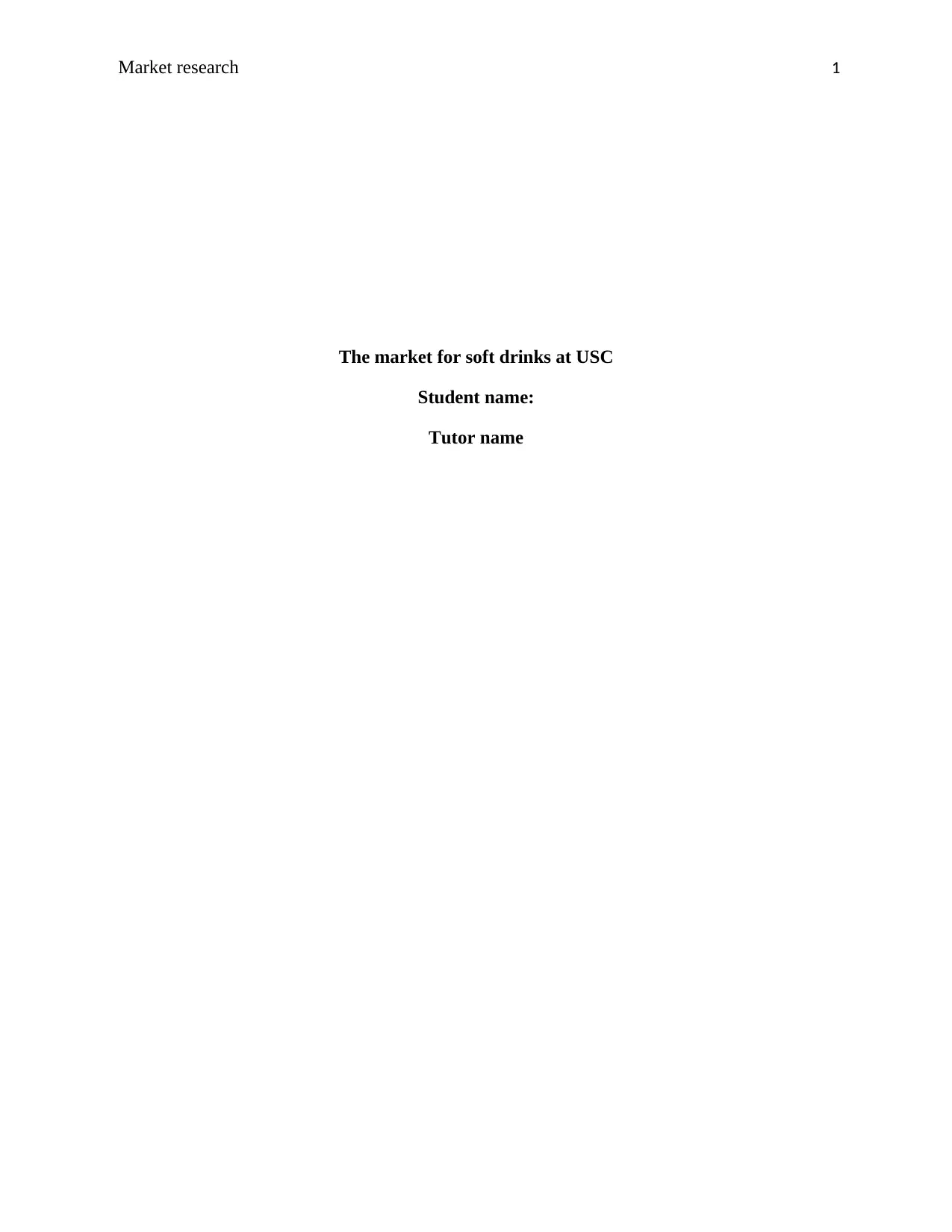
Market research 1
The market for soft drinks at USC
Student name:
Tutor name
The market for soft drinks at USC
Student name:
Tutor name
Paraphrase This Document
Need a fresh take? Get an instant paraphrase of this document with our AI Paraphraser

Market research 2
Introduction
Many businesses have struggled to stay afloat in the market that has been driven by high
competition. This has compelled business owners to invest in any method possible to ensure that
they maintain a firm grip on their customers. In order to understand the method to employ so as
to retain the customers, businesses have invested in approaches such as conducting market
research to be able to understand their customers and market trends better. It is against this
background that students at USC University decided to conduct a market research regarding the
consumption of drinks among students in the institution. The objective of this project was to
understand the students’ soft drink market at the university. Since it was impossible to conduct a
research of the whole population due to financial and time constraints, convenience sampling
method was employed; only BAC21 students constituted the sample that was used in this
research. The research used questionnaires as a tool for data collection. This was found
convenient since all the students were in one geographical location. The data collected was then
analyzed using the statistical analysis software, SPSS. Descriptive statistics such as students’
demographics were analyzed. Inferential statistics such as relationships between different
variables were also analyzed. The results were presented in tables and graphs as in the data
analysis section.
Data analysis and results
Table and graph of students’ distribution by origin
ORIGIN
NUMBE
R
PROPORTIO
N
International
student 17 0.085
Domestic student 183 0.915
Introduction
Many businesses have struggled to stay afloat in the market that has been driven by high
competition. This has compelled business owners to invest in any method possible to ensure that
they maintain a firm grip on their customers. In order to understand the method to employ so as
to retain the customers, businesses have invested in approaches such as conducting market
research to be able to understand their customers and market trends better. It is against this
background that students at USC University decided to conduct a market research regarding the
consumption of drinks among students in the institution. The objective of this project was to
understand the students’ soft drink market at the university. Since it was impossible to conduct a
research of the whole population due to financial and time constraints, convenience sampling
method was employed; only BAC21 students constituted the sample that was used in this
research. The research used questionnaires as a tool for data collection. This was found
convenient since all the students were in one geographical location. The data collected was then
analyzed using the statistical analysis software, SPSS. Descriptive statistics such as students’
demographics were analyzed. Inferential statistics such as relationships between different
variables were also analyzed. The results were presented in tables and graphs as in the data
analysis section.
Data analysis and results
Table and graph of students’ distribution by origin
ORIGIN
NUMBE
R
PROPORTIO
N
International
student 17 0.085
Domestic student 183 0.915
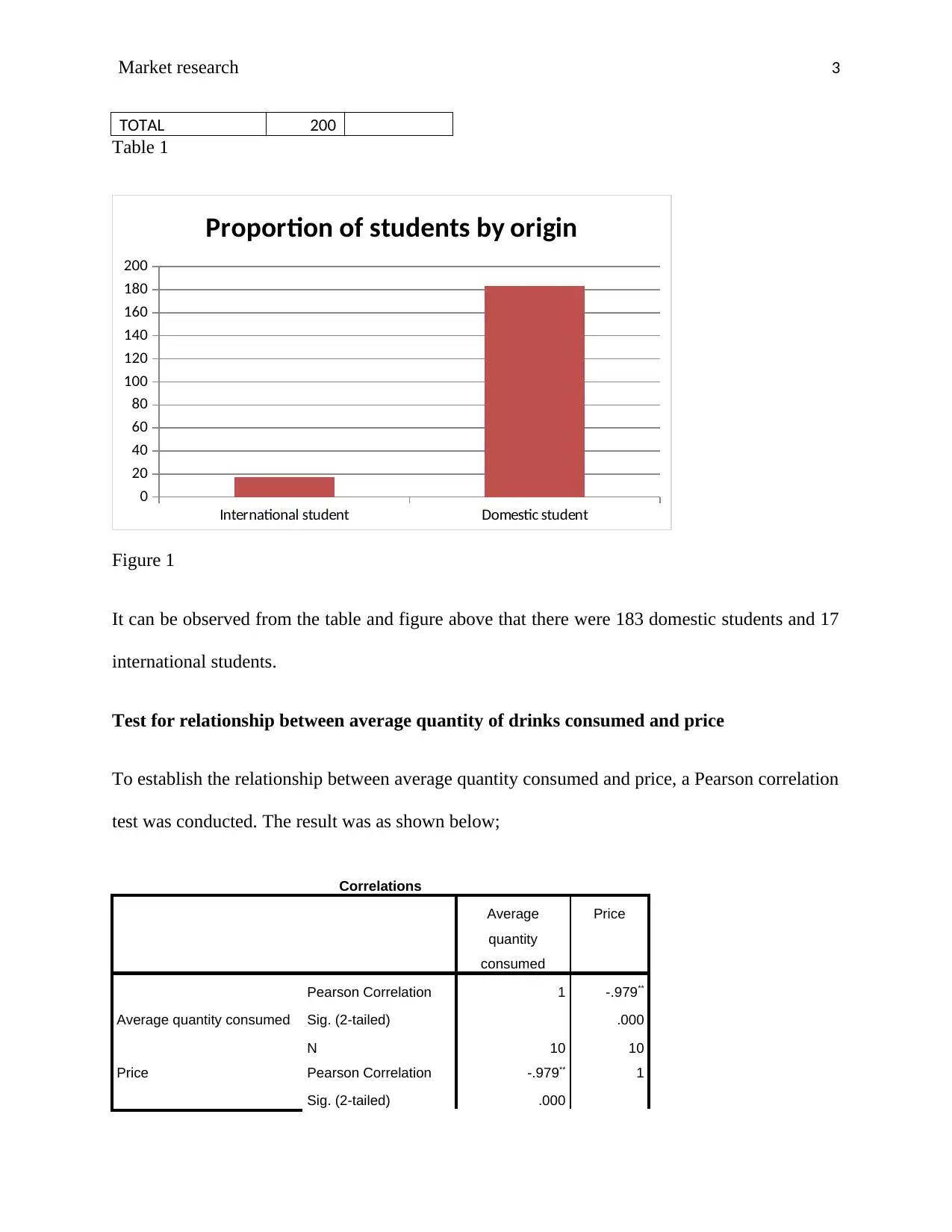
Market research 3
TOTAL 200
Table 1
International student Domestic student
0
20
40
60
80
100
120
140
160
180
200
Proportion of students by origin
Figure 1
It can be observed from the table and figure above that there were 183 domestic students and 17
international students.
Test for relationship between average quantity of drinks consumed and price
To establish the relationship between average quantity consumed and price, a Pearson correlation
test was conducted. The result was as shown below;
Correlations
Average
quantity
consumed
Price
Average quantity consumed
Pearson Correlation 1 -.979**
Sig. (2-tailed) .000
N 10 10
Price Pearson Correlation -.979** 1
Sig. (2-tailed) .000
TOTAL 200
Table 1
International student Domestic student
0
20
40
60
80
100
120
140
160
180
200
Proportion of students by origin
Figure 1
It can be observed from the table and figure above that there were 183 domestic students and 17
international students.
Test for relationship between average quantity of drinks consumed and price
To establish the relationship between average quantity consumed and price, a Pearson correlation
test was conducted. The result was as shown below;
Correlations
Average
quantity
consumed
Price
Average quantity consumed
Pearson Correlation 1 -.979**
Sig. (2-tailed) .000
N 10 10
Price Pearson Correlation -.979** 1
Sig. (2-tailed) .000
⊘ This is a preview!⊘
Do you want full access?
Subscribe today to unlock all pages.

Trusted by 1+ million students worldwide

Market research 4
N 10 10
**. Correlation is significant at the 0.01 level (2-tailed).
Table 2
0 1 2 3 4 5 6
0
2
4
6
8
10
12
14
f(x) = − 2.42406060606061 x + 11.6866666666667
R² = 0.957567581475249
Relationship of price and
consumption
Price
Average quantity consumed
Figure 2
It can be observed from table 2 and figure 2 that the correlation coefficient was -.98. This is an
indication that there is a strong relationship between the average quantity consumed and price.
However the relationship is negative. This means that an increase in price causes a decrease in
average quantity of drinks consumed.
N 10 10
**. Correlation is significant at the 0.01 level (2-tailed).
Table 2
0 1 2 3 4 5 6
0
2
4
6
8
10
12
14
f(x) = − 2.42406060606061 x + 11.6866666666667
R² = 0.957567581475249
Relationship of price and
consumption
Price
Average quantity consumed
Figure 2
It can be observed from table 2 and figure 2 that the correlation coefficient was -.98. This is an
indication that there is a strong relationship between the average quantity consumed and price.
However the relationship is negative. This means that an increase in price causes a decrease in
average quantity of drinks consumed.
Paraphrase This Document
Need a fresh take? Get an instant paraphrase of this document with our AI Paraphraser
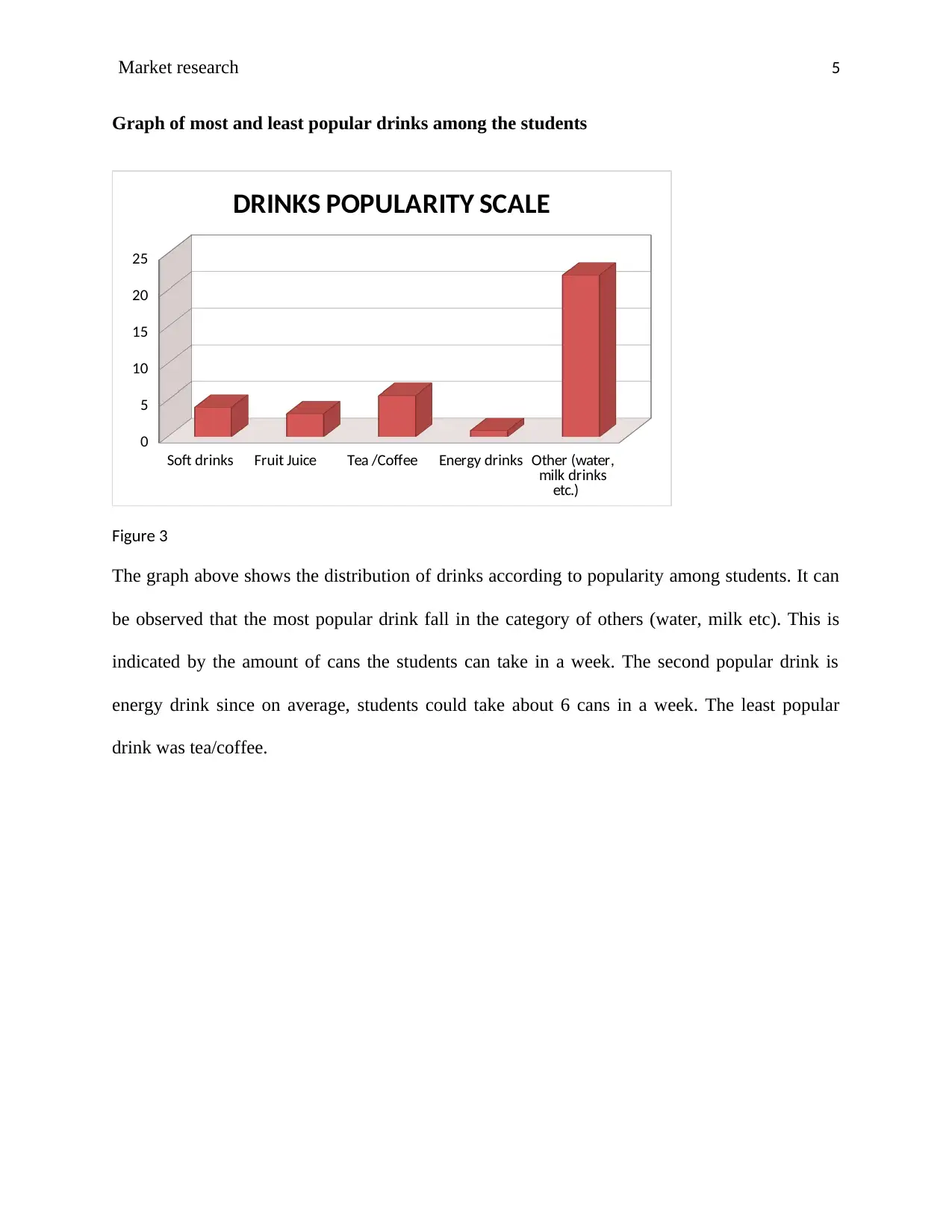
Market research 5
Graph of most and least popular drinks among the students
Soft drinks Fruit Juice Tea /Coffee Energy drinks Other (water,
milk drinks
etc.)
0
5
10
15
20
25
DRINKS POPULARITY SCALE
Figure 3
The graph above shows the distribution of drinks according to popularity among students. It can
be observed that the most popular drink fall in the category of others (water, milk etc). This is
indicated by the amount of cans the students can take in a week. The second popular drink is
energy drink since on average, students could take about 6 cans in a week. The least popular
drink was tea/coffee.
Graph of most and least popular drinks among the students
Soft drinks Fruit Juice Tea /Coffee Energy drinks Other (water,
milk drinks
etc.)
0
5
10
15
20
25
DRINKS POPULARITY SCALE
Figure 3
The graph above shows the distribution of drinks according to popularity among students. It can
be observed that the most popular drink fall in the category of others (water, milk etc). This is
indicated by the amount of cans the students can take in a week. The second popular drink is
energy drink since on average, students could take about 6 cans in a week. The least popular
drink was tea/coffee.

Market research 6
Students measure of loyalty after price reduction
AFTER 25% PRICE REDUCTION AFTER 40% PRICE REDUCTION
44
109
156
91
Loyalty after price reduction
YES NO
Figure 4
The graph above shows the change in demand in case the prices of drinks are reduced by 25%
and 40% respectively. It can be observed that out of 200 students only 44 of them said they
would change preference from their first choice drink if the price of the other drink is reduced by
25%. 156 said they could not change preference. On the other hand 91 out of 200 students said
they would not change their first choice even if the price is reduced by 40% while 109 said they
will change.
Difference in demand for soft drinks between domestic and international students
In order to establish whether there was a significant difference in demand for soft drinks between
international and domestic students, a paired t-test was employed to establish the same. The
hypothesis was as below;
Students measure of loyalty after price reduction
AFTER 25% PRICE REDUCTION AFTER 40% PRICE REDUCTION
44
109
156
91
Loyalty after price reduction
YES NO
Figure 4
The graph above shows the change in demand in case the prices of drinks are reduced by 25%
and 40% respectively. It can be observed that out of 200 students only 44 of them said they
would change preference from their first choice drink if the price of the other drink is reduced by
25%. 156 said they could not change preference. On the other hand 91 out of 200 students said
they would not change their first choice even if the price is reduced by 40% while 109 said they
will change.
Difference in demand for soft drinks between domestic and international students
In order to establish whether there was a significant difference in demand for soft drinks between
international and domestic students, a paired t-test was employed to establish the same. The
hypothesis was as below;
⊘ This is a preview!⊘
Do you want full access?
Subscribe today to unlock all pages.

Trusted by 1+ million students worldwide
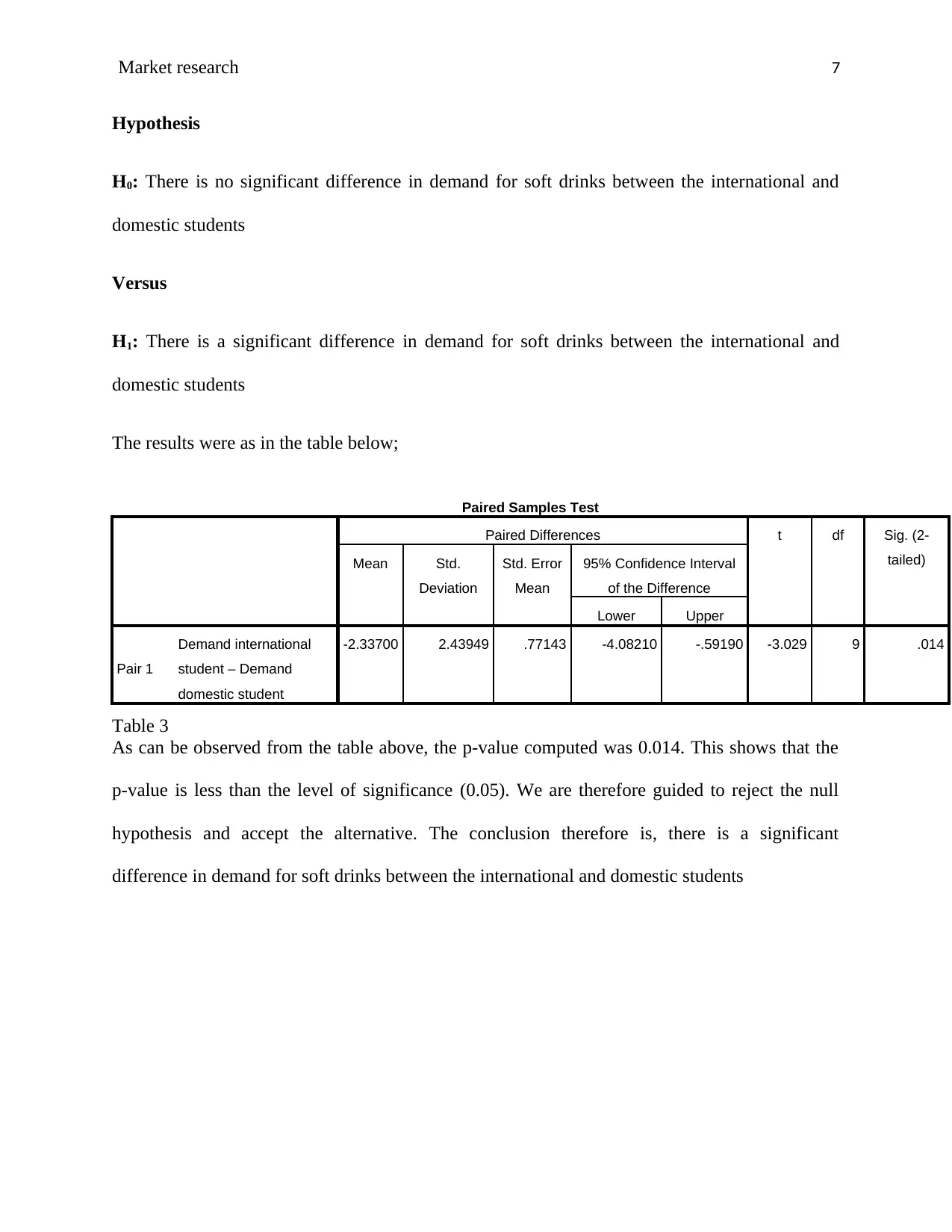
Market research 7
Hypothesis
H0: There is no significant difference in demand for soft drinks between the international and
domestic students
Versus
H1: There is a significant difference in demand for soft drinks between the international and
domestic students
The results were as in the table below;
Paired Samples Test
Paired Differences t df Sig. (2-
tailed)Mean Std.
Deviation
Std. Error
Mean
95% Confidence Interval
of the Difference
Lower Upper
Pair 1
Demand international
student – Demand
domestic student
-2.33700 2.43949 .77143 -4.08210 -.59190 -3.029 9 .014
Table 3
As can be observed from the table above, the p-value computed was 0.014. This shows that the
p-value is less than the level of significance (0.05). We are therefore guided to reject the null
hypothesis and accept the alternative. The conclusion therefore is, there is a significant
difference in demand for soft drinks between the international and domestic students
Hypothesis
H0: There is no significant difference in demand for soft drinks between the international and
domestic students
Versus
H1: There is a significant difference in demand for soft drinks between the international and
domestic students
The results were as in the table below;
Paired Samples Test
Paired Differences t df Sig. (2-
tailed)Mean Std.
Deviation
Std. Error
Mean
95% Confidence Interval
of the Difference
Lower Upper
Pair 1
Demand international
student – Demand
domestic student
-2.33700 2.43949 .77143 -4.08210 -.59190 -3.029 9 .014
Table 3
As can be observed from the table above, the p-value computed was 0.014. This shows that the
p-value is less than the level of significance (0.05). We are therefore guided to reject the null
hypothesis and accept the alternative. The conclusion therefore is, there is a significant
difference in demand for soft drinks between the international and domestic students
Paraphrase This Document
Need a fresh take? Get an instant paraphrase of this document with our AI Paraphraser
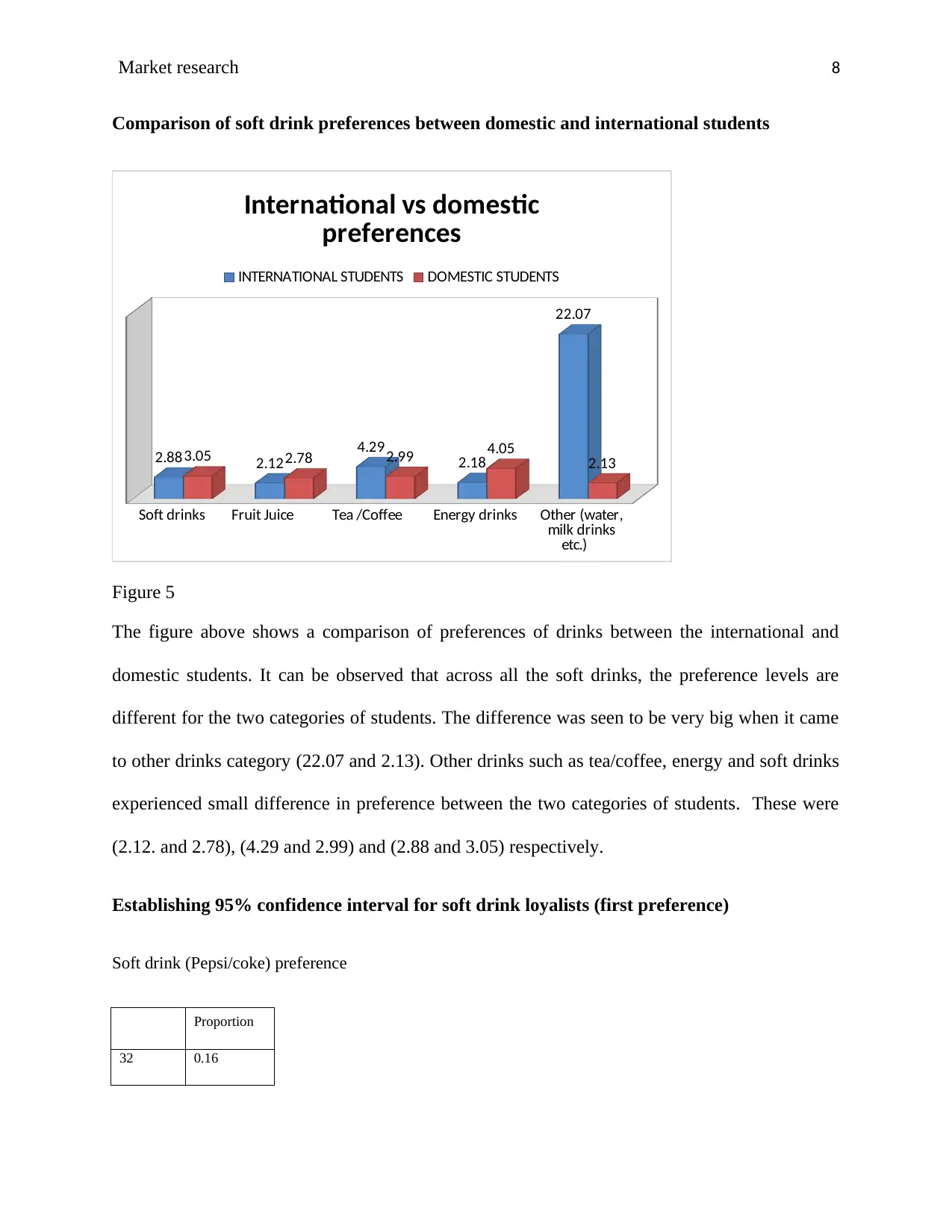
Market research 8
Comparison of soft drink preferences between domestic and international students
Soft drinks Fruit Juice Tea /Coffee Energy drinks Other (water,
milk drinks
etc.)
2.88 2.12
4.29
2.18
22.07
3.05 2.78 2.99 4.05 2.13
International vs domestic
preferences
INTERNATIONAL STUDENTS DOMESTIC STUDENTS
Figure 5
The figure above shows a comparison of preferences of drinks between the international and
domestic students. It can be observed that across all the soft drinks, the preference levels are
different for the two categories of students. The difference was seen to be very big when it came
to other drinks category (22.07 and 2.13). Other drinks such as tea/coffee, energy and soft drinks
experienced small difference in preference between the two categories of students. These were
(2.12. and 2.78), (4.29 and 2.99) and (2.88 and 3.05) respectively.
Establishing 95% confidence interval for soft drink loyalists (first preference)
Soft drink (Pepsi/coke) preference
Proportion
32 0.16
Comparison of soft drink preferences between domestic and international students
Soft drinks Fruit Juice Tea /Coffee Energy drinks Other (water,
milk drinks
etc.)
2.88 2.12
4.29
2.18
22.07
3.05 2.78 2.99 4.05 2.13
International vs domestic
preferences
INTERNATIONAL STUDENTS DOMESTIC STUDENTS
Figure 5
The figure above shows a comparison of preferences of drinks between the international and
domestic students. It can be observed that across all the soft drinks, the preference levels are
different for the two categories of students. The difference was seen to be very big when it came
to other drinks category (22.07 and 2.13). Other drinks such as tea/coffee, energy and soft drinks
experienced small difference in preference between the two categories of students. These were
(2.12. and 2.78), (4.29 and 2.99) and (2.88 and 3.05) respectively.
Establishing 95% confidence interval for soft drink loyalists (first preference)
Soft drink (Pepsi/coke) preference
Proportion
32 0.16
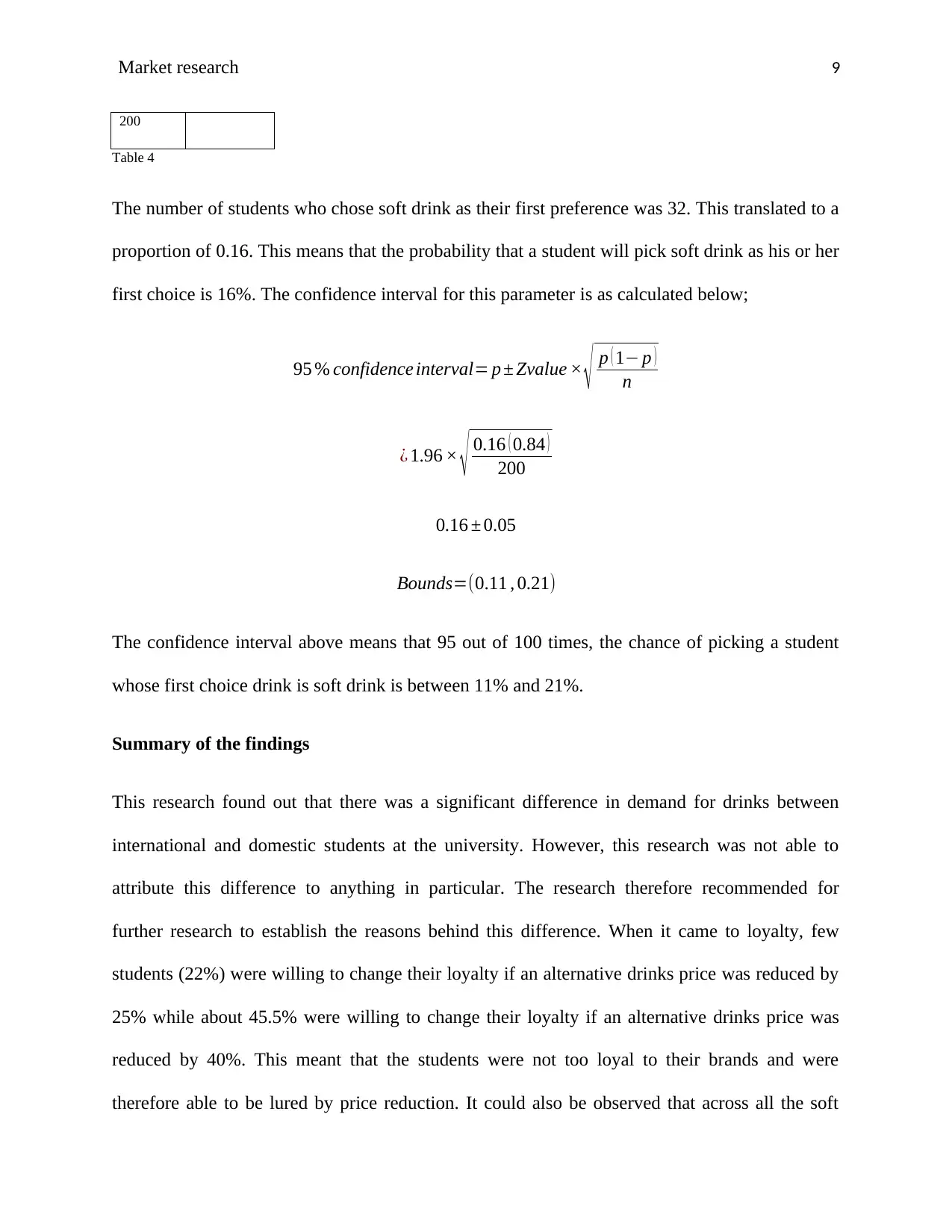
Market research 9
200
Table 4
The number of students who chose soft drink as their first preference was 32. This translated to a
proportion of 0.16. This means that the probability that a student will pick soft drink as his or her
first choice is 16%. The confidence interval for this parameter is as calculated below;
95 % confidence interval= p ± Zvalue × √ p ( 1− p )
n
¿ 1.96 × √ 0.16 ( 0.84 )
200
0.16 ± 0.05
Bounds=(0.11 , 0.21)
The confidence interval above means that 95 out of 100 times, the chance of picking a student
whose first choice drink is soft drink is between 11% and 21%.
Summary of the findings
This research found out that there was a significant difference in demand for drinks between
international and domestic students at the university. However, this research was not able to
attribute this difference to anything in particular. The research therefore recommended for
further research to establish the reasons behind this difference. When it came to loyalty, few
students (22%) were willing to change their loyalty if an alternative drinks price was reduced by
25% while about 45.5% were willing to change their loyalty if an alternative drinks price was
reduced by 40%. This meant that the students were not too loyal to their brands and were
therefore able to be lured by price reduction. It could also be observed that across all the soft
200
Table 4
The number of students who chose soft drink as their first preference was 32. This translated to a
proportion of 0.16. This means that the probability that a student will pick soft drink as his or her
first choice is 16%. The confidence interval for this parameter is as calculated below;
95 % confidence interval= p ± Zvalue × √ p ( 1− p )
n
¿ 1.96 × √ 0.16 ( 0.84 )
200
0.16 ± 0.05
Bounds=(0.11 , 0.21)
The confidence interval above means that 95 out of 100 times, the chance of picking a student
whose first choice drink is soft drink is between 11% and 21%.
Summary of the findings
This research found out that there was a significant difference in demand for drinks between
international and domestic students at the university. However, this research was not able to
attribute this difference to anything in particular. The research therefore recommended for
further research to establish the reasons behind this difference. When it came to loyalty, few
students (22%) were willing to change their loyalty if an alternative drinks price was reduced by
25% while about 45.5% were willing to change their loyalty if an alternative drinks price was
reduced by 40%. This meant that the students were not too loyal to their brands and were
therefore able to be lured by price reduction. It could also be observed that across all the soft
⊘ This is a preview!⊘
Do you want full access?
Subscribe today to unlock all pages.

Trusted by 1+ million students worldwide

Market research
10
drinks, the preference levels are different for the two categories of students. This research also
revealed that price was a real determinant of the amount of cans of soft drinks students took in a
week. A rise in price led to a reduction in average consumption of the drinks per week. The
converse was also true.
10
drinks, the preference levels are different for the two categories of students. This research also
revealed that price was a real determinant of the amount of cans of soft drinks students took in a
week. A rise in price led to a reduction in average consumption of the drinks per week. The
converse was also true.
1 out of 10
Related Documents
Your All-in-One AI-Powered Toolkit for Academic Success.
+13062052269
info@desklib.com
Available 24*7 on WhatsApp / Email
![[object Object]](/_next/static/media/star-bottom.7253800d.svg)
Unlock your academic potential
Copyright © 2020–2025 A2Z Services. All Rights Reserved. Developed and managed by ZUCOL.





